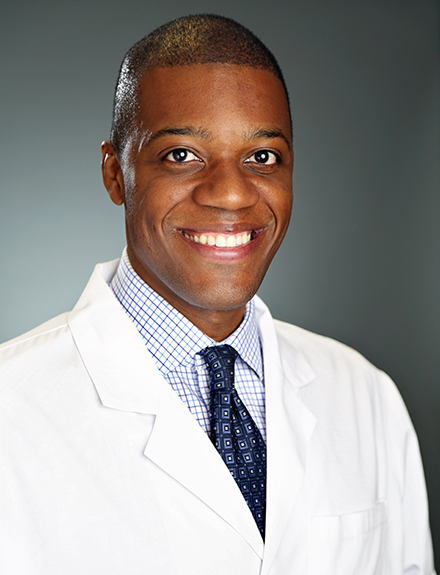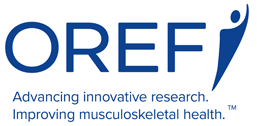

Phillip Williams, MD
OREF Resident Clinician Scientist Training Grant
Research Topic
Investigating the role of scapular motion in asymptomatic rotator cuff tears
Patient Impact
Development of a novel, targeted therapy for patients with symptomatic rotator cuff tears that mimics the scapular kinematics of those with asymptomatic tears. This new therapy could help patients with symptomatic tears cope, giving them a well-functioning shoulder without the need for operative repair.
Shoulder Kinematics
OREF grant recipient aims to improve early detection and rehabilitation of rotator cuff tears
Mark Crawford, OREF contributing writer
Discomfort and disability resulting from shoulder pathology is increasingly common among older individuals, especially from rotator cuff tears (RCTs). RCTs occur in more than 50 percent of people over 60 years of age.
Treatment for symptomatic RCTs typically requires surgery; however, associated risks include infection, foreign body reaction, and neurologic injury.
“Symptomatic RCTs can be a disabling condition with few treatment options other than surgery, said Phillip N. Williams, MD, assistant professor in the department of orthopaedics at University of Texas Health Science Center at Houston. “Rehabilitation of these pathologic shoulders can also be challenging.”
Recent studies have shown that people with asymptomatic pathologic shoulders develop abnormal scapular motion compared to those with healthy shoulders, but these differences are not well-understood.
“We’d like to learn if patients with asymptomatic RCTs have different scapular motion than individuals with healthy shoulders,” said Dr. Williams. “Understanding these differences could lead to improved rehabilitation protocols that use scapular adaptation. We’d like to limit the necessity of operative repair yet still provide individuals with a well-functioning shoulder.”
As an orthopaedic surgery resident at the Hospital for Special Surgery in New York, , Dr. Williams received an Orthopaedic Research and Education Foundation (OREF) Resident Clinician Scientist Training Grant to investigate the role of scapular motion in asymptomatic RCTs. Dr. Williams, hoped to determine how individuals with asymptomatic RCTs cope with their pathologic shoulders by changing their scapular kinematics.
Shoulders in Motion
Using opto-electric 3-D motion analysis, Dr. Williams and his research team compared scapular kinematics—scaption, forward flexion, and abduction—between individuals with asymptomatic RCTs and aged-matched healthy controls.
Forty asymptomatic, pain-free adults aged 63 or older who had no history of shoulder pathology participated in the study. Dr. Williams and his research team recorded 3-D kinematic data—glenohumeral, scapulothoracic, and humerothoracic—for a set of standard shoulder movements performed by the participants with their dominant shoulder: full humeral elevation (0 degrees to180 degrees) in frontal (abduction), scapular (scaption), and sagittal (forward flexion) planes.
The researchers calculated the scapular slope (humeral motion vs. scapular motion) for ascending and descending directions for shoulder abduction, forward flexion, and scaption. They confirmed RC integrity or the presence of any pathology with ultrasound.
“Our working hypothesis was that humerus-to-scapula and scapula-to-trunk kinematics would be different between individuals with asymptomatic rotator cuff tears and healthy controls for scaption, forward flexion, and abduction,” said Dr. Williams. “Our hope is that if there is a difference in scapular kinematics between individuals with asymptomatic RCTs and healthy controls, then we can develop a tool for early diagnosis based upon function. Subtle differences between individuals with asymptomatic RCTs and healthy controls could also be used to develop rehabilitation protocols, and possibly surgical solutions, to prevent progression to symptomatic and arthritic shoulder states.”
Better shoulder therapies
Thirty-one of the 40 subjects presented rotator cuff pathology. Seven had RCTs and 24 showed varying degrees of tendinosis. Scapular range of motion was similar between subjects without RC pathology and subjects with asymptomatic RC pathology in shoulder abduction, forward flexion, and scaption. The researchers also found no significant differences in ascending or descending scapular slope for shoulder abduction and scaption, regardless of RC condition.
However, subjects without RC pathology had a statistically significant difference between ascending and descending scapular slope in forward flexion (p=0.021) when compared to those with shoulder pathology. This difference may be the result of a mechanism those with pathologic shoulder conditions developed to cope and warrants further study.
Dr. Williams hopes that future comparisons to symptomatic RCT patients will reveal key differences in shoulder kinematics, which can then be used to develop new rehabilitation approaches.
“We are interested in the kinematics of the asymptomatic group because they are copers who have been able to tolerate a rotator cuff tear,” Dr. Williams said. “Learning these differences in kinematics could help us develop therapy that mimics the scapular kinematics of someone with an asymptomatic RCT. The idea is for the new therapy to help the symptomatic patient cope with a tear.”
New tools for success
Ultimately, Dr. Williams hopes the results from this project will lead to non-invasive treatments to lessen the burden of a disease that significantly affects a large proportion of the population. In addition, this work will give sports medicine physicians and physical therapists new tools for treating patients with RCTs both non-operatively and post-operatively.
Now a member of the sports medicine department at UT Houston, Dr. Williams continues to be interested in shoulder kinematics. He and his research team have completed a manuscript based on the findings from their OREF-funded research and have submitted it for publication in journals and to present at meetings.
Dr. Williams said that he would like to continue working in kinematics and mapping out the way the body moves normally and in pathologic states. He is thankful to OREF for giving him the vote of confidence to pursue these topics and inspiring him to pursue an academic practice career.
“OREF funding was instrumental in getting my research off the ground, and I think the grant gave me an audience of orthopaedic surgeons who were interested in my analysis and input,” Dr. Williams said. “The grant gave me networking opportunities I didn’t know were possible. It was a stepping stone, and I can already see my career progressing in a way that was unimaginable before I received the grant.”
